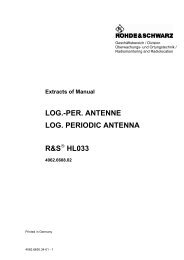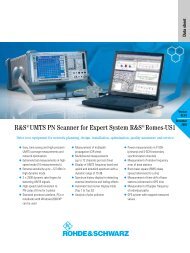Glossary of Video Terms and Acronyms - Isotest
Glossary of Video Terms and Acronyms - Isotest
Glossary of Video Terms and Acronyms - Isotest
Create successful ePaper yourself
Turn your PDF publications into a flip-book with our unique Google optimized e-Paper software.
<strong>Video</strong> <strong>Terms</strong> <strong>and</strong> <strong>Acronyms</strong><br />
<strong>Glossary</strong><br />
Tint function in that it changes color saturation as well as type <strong>of</strong> color. In<br />
most cases where ACC is present, it cannot be defeated. Adjusting the<br />
color <strong>and</strong> tint controls, using the SMPTE Color Bar pattern <strong>and</strong> the blue filter<br />
will result in a gross misadjustment <strong>of</strong> color level on the set. The color<br />
level may have to be reduced by as much as half the value calibrated with<br />
the SMPTE Color Bar pattern.<br />
Automatic Focus – A feature on most consumer <strong>and</strong> industrial video<br />
cameras <strong>and</strong> camcorders that automatically makes minor focal length<br />
adjustments, thus freeing the videographer from focusing concerns.<br />
Automatic Frequency Control (AFC) – Automatic frequency control.<br />
Commonly used to lock onto <strong>and</strong> track a desired frequency.<br />
Automatic Gain Control (AGC) – a) Circuitry used to ensure that output<br />
signals are maintained at constant levels in the face <strong>of</strong> widely varying input<br />
signal levels. AGC is typically used to maintain a constant video luminance<br />
level by boosting weak (low light) picture signals electronically. Some equipment<br />
includes gain controls that are switchable between automatic <strong>and</strong><br />
manual control. b) Electronic circuitry that compensates for either audio or<br />
video input level changes by boosting or lowering incoming signals to match<br />
a preset level. Using AGC, changing input levels can output at a single constant<br />
setting. c) A feature on most video cameras <strong>and</strong> camcorders that,<br />
when engaged, boosts the signal to its optimum output level. Automatic gain<br />
control (AGC) is available for video, <strong>and</strong> less frequently audio use.<br />
Automatic Iris – A feature on most video cameras <strong>and</strong> camcorders that<br />
automatically creates the lens aperture that allows the imaging device to<br />
perform under optimum conditions.<br />
Automatic Level Control (ALC) – Circuitry used to automatically adjust<br />
the audio recording level to compensate for variations in input volume.<br />
Some equipment includes level controls that are switchable between automatic<br />
<strong>and</strong> manual control.<br />
Automatic Picture Stop – The disc player will automatically take the program<br />
from the play mode to a still frame mode according to information<br />
programmed in the vertical interval <strong>of</strong> the disc’s video.<br />
Automatic Route Selection – An important part <strong>of</strong> an automatic leastcost<br />
routing system.<br />
Automatic Shut-Off – A device (usually a mechanical switch) incorporated<br />
into most tape recorders that automatically stops the machine when the<br />
tape runs out or breaks.<br />
14 www.tektronix.com/video_audio<br />
Auto-Pan – A feature exclusive to AVC series switchers causing a positioned<br />
pattern to center itself as it grows in size.<br />
Autotiming – Capability <strong>of</strong> some digital video equipment to automatically<br />
adjust input video timing to match a reference video input. Eliminates the<br />
need for manual timing adjustments.<br />
Auto-Transition – a) The ability to electronically simulate a fader motion<br />
over an operator-specified duration. b) An automatic transition where the<br />
motion <strong>of</strong> the switcher lever arm is electronically simulated when the AUTO<br />
TRANS pushbutton is pressed. The duration <strong>of</strong> the transition in television<br />
frames or seconds is indicated by the rate display LED.<br />
Auxiliary Bus – A bus which has the same video sources as the switcher<br />
but whose crosspoints may be remotely controlled, independently <strong>of</strong> the<br />
switcher console.<br />
Auxiliary Channel (AUX) – In a video editing system, a channel reserved<br />
for connection to an external audio <strong>and</strong>/or video device.<br />
AVI (Audio <strong>Video</strong> Interleaved) – The <strong>Video</strong> for Windows file format for<br />
digital video <strong>and</strong> audio. An AVI (.avi) file is a RIFF file format used with<br />
applications that capture, edit <strong>and</strong> playback audio/video sequences. AVI<br />
files contain multiple streams <strong>of</strong> different types <strong>of</strong> data. Most AVI<br />
sequences will use both audio <strong>and</strong> video data streams. Specialized AVI<br />
sequences might include control track as an additional data stream. See<br />
<strong>Video</strong> for Windows.<br />
A-Vision – An ATV system proponent.<br />
AWGN – Additive White Gaussian Noise.<br />
Axis – An imaginary line through the video image used as a reference<br />
point for rotation <strong>and</strong> movement. The three axes are H (horizontal), Y (vertical),<br />
<strong>and</strong> A (depth).<br />
Azimuth – The angle <strong>of</strong> a tape head’s recoding gap relative to the tape.<br />
Azimuth Alignment – Alignment <strong>of</strong> the recoding <strong>and</strong> reproducing gaps so<br />
that their center lines lie parallel with each other <strong>and</strong> at right angles to the<br />
direction <strong>of</strong> head/tape motion. Misalignment <strong>of</strong> the gaps causes a loss in<br />
output at short wavelengths. For example, using a track width <strong>of</strong> 50 mils, a<br />
misalignment <strong>of</strong> only 0.05 degrees will cause a 3 dB loss at a wavelength<br />
<strong>of</strong> 0.1 mil.<br />
Azimuth Loss – High frequency losses caused by head misalignment.





